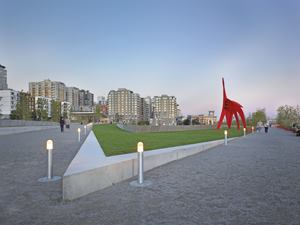DETAILS
DETAILS
PROJECT Olympic Sculpture Park, Seattle
CLIENT Seattle Art Museum, Seattle
LEAD DESIGNER: SITE DESIGN/ARCHITECTURE Weiss/Manfredi Architecture/Landscape/Urbanism, New York
LIGHTING DESIGNER Brandston Partnership Inc., New York
CONSULTANTS: STRUCTURAL AND CIVIL ENGINEERING Magnusson Klemencic Associates, Seattle
LANDSCAPE ARCHITECTURE Charles Anderson Landscape Architecture, Seattle
MECHANICAL AND ELECTRICAL ENGINEERING ABACUS Engineered Systems, Seattle
GEOTECHNICAL ENGINEERING Hart Crowser, Seattle
ENVIRONMENTAL CONSULTANT Aspect Consulting, Seattle
AQUATIC ENGINEERING Anchor Environmental, Seattle
PROJECT SIZE 9 acres
PROJECT COST $85 million
PHOTOGRAPHERS Ben Benschneider, Seattle; and Paul Warchol, New York
Once a desolate and contaminated area formerly used for industrial purposes, the site of Seattle’s new Olympic Sculpture Park has been transformed into an urban sanctuary where art, nature, and infrastructure harmoniously coexist. The site, a 9-acre parcel of land on Seattle’s downtown waterfront, is now owned and operated by the Seattle Art Museum. In 2001, the museum, with support from the National Endowment of the Arts, held an international competition to find a designer that could not only reinvent the site but also form a connection between the city and its neglected shoreline.
The museum selected New York-based Weiss/Manfredi Architecture/Landscape/Urbanism as lead designer from a pool of 52 applicants, a firm ideally suited for such a project based on its cross-discipline expertise in architecture, landscape, and urban design. Resolving to return the site to a functioning ecosystem, while providing a one-of-a-kind setting for outdoor sculpture and public recreation, the museum turned to Weiss/Manfredi’s innovative competition design—a continuous and constructed landscape rising over existing infrastructure and connecting three separate brownfield sites into one uninterrupted z-shaped landform that wanders from the city to the water’s edge.
Affording an array of environmental restoration processes, including brownfield remediation and the creation of a salmon habitat, the design also offers sweeping panoramic views of Puget Sound, the Olympic Mountains, Mount Rainier, and the surrounding city. The design provides “a broad, continuous ribbon where all kinds of different art can be sited,” says Michael Manfredi, design partner at Weiss/Manfredi. The firm also addressed the site’s significant infrastructural challenges, including an arterial highway and railway lines. Instead of enclosing them, Weiss/Manfredi built up the site’s topography by 40 feet, in turn creating a seamless and slow decent down to the 850-foot strip of restored shoreline.
Unlike other sculpture gardens that are hidden behind a series of museum walls, the Olympic Sculpture Park is completely open, integrating the park into the landscape of the city. Because of its open nature, the site required a lighting scheme that would not overwhelm its natural surroundings or draw attention away from the artwork. Weiss/Manfredi worked closely with New York-based lighting design firm Brandston Partnership Inc. (BPI) to design a subtle, integrated lighting scheme that was flexible and maintenance-friendly.
“In my view, the beauty of this project is that the lighting does not have to do much; the architecture is so open, welcoming, and beautiful already. We only used the light to present the elements as they were designed,” says lighting designer Chou Lien, partner at BPI. Already a major component to the park, nature also played an important role in its general illumination, which was provided by natural light from the night sky as well as surrounding streetlights and buildings. As Chou explains, “The sculptures are not solo objects, they are part of a large environment, to be seen at night with other light conditions nearby.”
One building that provides such light is the park’s PACCAR Pavilion, an 18,000-square-foot glass and steel structure located at the park’s main entrance that houses exhibition and event space, areas for educational programming, underground parking, a bookshop, and a café. Designed as an extension of the z-shaped landform, the pavilion—which includes a series of cantilevered roofs and stepped terraces—links the indoor and outdoor spaces via folded stainless steel and mirrored frit glass that capture the reflections of the surrounding city and landscape.
Outside, 250W quartz halogen fixtures uplight the building’s canopies. Inside, low-wattage track-mounted luminaires with 50W incandescent AR70 quartz lamps accent artwork and architectural features, providing a setting for art and special events and offering flexibility for changing exhibits and functions. In addition, 250W DC quartz uplights have been placed in parts of the double-height space to fully illuminate the structure’s form, transforming the pavilion at dusk into a glowing lantern. “We see the pavilion as a place of sanctuary as well as a place of celebration,” Chou says.
